
|
|
Car Help
Muffler Job |
|
Maintained by
suitti@uitti.net,
Stephen Uitti |

The old muffler was coming unglued. Welds disintegrated. The pipes rotted at stress points near joints. There are three pieces here. From towards the front of the car at the top of the picture, the straight pipe, the bent pipe, and the muffler. I've made up some these terms. The auto parts stores don't have better names. In fact, i knew which pipe to buy most recently, because it was the pipe i didn't most recently buy. They were able to look up my purchase history on the cash register. It appears I'm buying a 1988 Mazda 626 there, one piece at time. In this picture, the front of the car is on the top. The straight pipe and the bent pipe are still attached together. Each has a flange, and they are bolted together. Perhaps it is more accurate at this stage to say that they are rusted together. Then, the muffler is on the bottom.
The three items sort of died more or less at the same time. The bent pipe was purchased first. Then it was found that what was really needed was the muffler. So, a muffler was purchased. While trying to figure out how to do this job, the straight pipe came unglued.
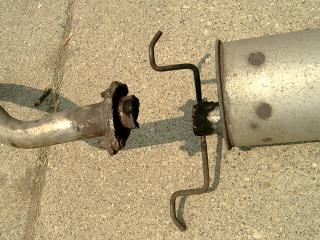 Here is the reason why the muffler is bad. The muffler itself
is fine. Just before it separated from the bent pipe, the
car sounded fine. Now, this car, a 1988 Mazda 626 with
a 2.2 liter fuel injected 12 valve 4 cylinder engine, is actually
pretty quiet even without the muffler. In fact, a few years
ago, the muffler had come off.
On the way to get it replaced
a stop was made at a traffic light. A newish Mustang
modified with headers (can one get a Mustang with factory headers?)
pulled up along side at the light.
Both cars were at idle. My car was inaudible.
When the light turned green, both cars pulled forward.
My car was still inaudible. Now the engine is designed
with the idea that there will be a certain amount of
back pressure. If it isn't there, it's hard on the
valves, and the end result can be a valve job. That's significant.
The cylinder head comes off, gets carted to a head shop to
have the valve job, and it gets put back on the car. It can run
$1000 easy. It's essentially an overhaul. One can save
much of the cost by taking off the cylinder head, bringing it
to the head shop, and putting
it back on later. A head kit is needed, which has the gaskets
and such. A torque wrench is required for reassembly. Otherwise
the bolts won't be tightened the right amount. It might
work for a bit without it.
Here is the reason why the muffler is bad. The muffler itself
is fine. Just before it separated from the bent pipe, the
car sounded fine. Now, this car, a 1988 Mazda 626 with
a 2.2 liter fuel injected 12 valve 4 cylinder engine, is actually
pretty quiet even without the muffler. In fact, a few years
ago, the muffler had come off.
On the way to get it replaced
a stop was made at a traffic light. A newish Mustang
modified with headers (can one get a Mustang with factory headers?)
pulled up along side at the light.
Both cars were at idle. My car was inaudible.
When the light turned green, both cars pulled forward.
My car was still inaudible. Now the engine is designed
with the idea that there will be a certain amount of
back pressure. If it isn't there, it's hard on the
valves, and the end result can be a valve job. That's significant.
The cylinder head comes off, gets carted to a head shop to
have the valve job, and it gets put back on the car. It can run
$1000 easy. It's essentially an overhaul. One can save
much of the cost by taking off the cylinder head, bringing it
to the head shop, and putting
it back on later. A head kit is needed, which has the gaskets
and such. A torque wrench is required for reassembly. Otherwise
the bolts won't be tightened the right amount. It might
work for a bit without it.
So, the pipe on the left here shown above with the muffler has both flanges bolted together. That's both the one for the bent pipe, and the one for the muffler. About an inch from the joint is the break. It's probably a stress point. The broken bit of pipe on the muffler side is blackened for two reasons. First, when the thing broke, the raw exhaust was aimed at various points on the muffler. A splice was jury rigged using a couple of muffler pipe U-bolts and a tuna fish can. Recycling hadn't been taken out yet. It seemed to work for a couple months. It leaked a little exhaust, and the muffler goop didn't help, but the car was quiet and nothing was getting into the cabin. In the mean time, parts were ordered and strategy was considered. Apparently, i was confused on first inspection. Whereas clearly a new muffler was required, a new bent pipe was purchased. When I looked at how to get the bent pipe off of the car, there were two problems. One was that the forward joint (to the straight pipe) was rusted together. The other was that there was nothing wrong with the bent pipe - it was the muffler that needed to be replaced. It had spent so long in the jury rigged condition that the 90 day return policy had expired. They'd charge a 20% restocking fee anyway. Fine.
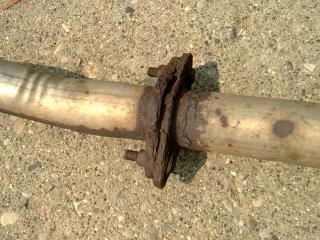 The bolts holding the straight and bent pipes are rusted tight.
Since i needed
to remove both parts, i didn't bother taking these apart.
Sometimes you can't do this without a lift, but was able to
twist them, nudge them, twist some more, and they came out
as a unit. Without any overstatement, i'm world class
at this spatial relationships thing.
Even compared to other engineers. Yet, the couch
in my basement is going to stay there. That's another story,
worthy of Dirk Gently.
The bolts holding the straight and bent pipes are rusted tight.
Since i needed
to remove both parts, i didn't bother taking these apart.
Sometimes you can't do this without a lift, but was able to
twist them, nudge them, twist some more, and they came out
as a unit. Without any overstatement, i'm world class
at this spatial relationships thing.
Even compared to other engineers. Yet, the couch
in my basement is going to stay there. That's another story,
worthy of Dirk Gently.
It's very hard to tell, even in the 1600x1200 original shot, that significant damage was done to one of the nuts. This was performed using the broken nut cracker. That's when it was decided that a new nut cracker was needed. However, the new nut cracker didn't do much here either.
On the other hand, the pipe on the right - the bent pipe, shows considerable rust less than an inch from the joint. There is probably another year of life in it. It's tempting to put it back on the car. It's less tempting to store it until possibly needed. As a pack rat, it's tempting to keep the nearly working muffler, too.
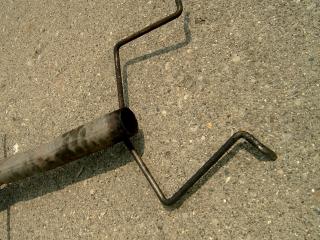 The broken end of the straight pipe looks clean. Only
the fact that the flange that is supposed to be there
was still attached to the next pipe on the car was a
clue. It appears that the weld holding this pipe to
the flange completely came off. Again it was
jury rigged. The car was rolled up onto blocks.
It was to be an inspection only, as there was only about
five or ten minutes before it was time to go to the next
appointment. The pipe was pushed back into alignment
with the next pipe. It stayed, more or less.
Some 20 inches (half a meter) of bailing wire was grabbed,
and wrapped it around the hangers (shown) and the flanges (not shown)
that were still on the car. It leaked alot, but was reasonably
quiet. I probably drove over 1,000 miles on it this
way - most of it on the highway. That's good, because
when stopped, it leaked exhaust into the cabin.
A thousand miles is only a couple weeks. Was it mentioned
that this car goes about thirty five thousand miles a year?
The broken end of the straight pipe looks clean. Only
the fact that the flange that is supposed to be there
was still attached to the next pipe on the car was a
clue. It appears that the weld holding this pipe to
the flange completely came off. Again it was
jury rigged. The car was rolled up onto blocks.
It was to be an inspection only, as there was only about
five or ten minutes before it was time to go to the next
appointment. The pipe was pushed back into alignment
with the next pipe. It stayed, more or less.
Some 20 inches (half a meter) of bailing wire was grabbed,
and wrapped it around the hangers (shown) and the flanges (not shown)
that were still on the car. It leaked alot, but was reasonably
quiet. I probably drove over 1,000 miles on it this
way - most of it on the highway. That's good, because
when stopped, it leaked exhaust into the cabin.
A thousand miles is only a couple weeks. Was it mentioned
that this car goes about thirty five thousand miles a year?
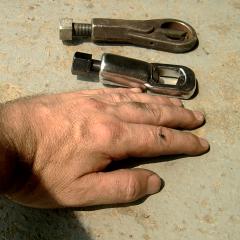 Still, one has to remove the rusted bolts somewhere.
At the very least, an old flange somewhere needs to be
removed so that the new flange can be bolted to the
still working part. Always try a wrench first. It
almost never works, but when it does, it's much easier
than anything else. The next idea is to
try a nut cracker. The idea is to physically
break the nuts, and then remove the bits with
vice grips.
Still, one has to remove the rusted bolts somewhere.
At the very least, an old flange somewhere needs to be
removed so that the new flange can be bolted to the
still working part. Always try a wrench first. It
almost never works, but when it does, it's much easier
than anything else. The next idea is to
try a nut cracker. The idea is to physically
break the nuts, and then remove the bits with
vice grips.
The way one uses a nut cracker is that the tool is placed around the nut, and the bolt is cranked until the cutting edge has cut all the way through the nut.
Two nut crackers are shown. The top one cuts the nut from the same side as the bolt, and the other cuts from the opposite side. One might think that this is redundant, but it isn't, and for two reasons. First is that when working on the car, there is seldom much room. One often can't orient the tool to more than one position. This was certainly case for this job. Second, the upper nut cracker is broken. There is supposed to be a set screw whose job is to keep the cutting edge from twisting. There's something wrong with it, and the cutting edge twists all over the place. I managed to mangle a nut with it, however, so I'll keep it. Perhaps it's masochism. Everyone needs some sort of neurosis to stay normal.
These nut crackers didn't do the trick. However, several hours were spent in the attempt. This is where the professional mechanic has an advantage over the home mechanic. The pro will spend a few minutes on an idea like this and then get out the torch. Also, the pro has the car on a lift, and isn't attempting to do the entire job while on his back with two inches of clearance or less. That's one reason that this was a ten hour job, while the pro would be done in one hour. I don't have a torch or a lift, yet.
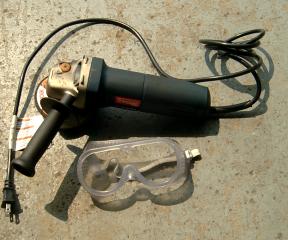 The next idea was to use a masonry cutter. This was
purchased with a three projects in mind. None of
these projects have been started. Two of these involve
cutting drainage ditches in concrete. The third involves
cutting a hole in the garage floor so that a pit can
be dug so that instead of lifting the car, one could
work on the underside by just getting into the pit
which is below the car. More on this project if it
ever gets below the ground.
The next idea was to use a masonry cutter. This was
purchased with a three projects in mind. None of
these projects have been started. Two of these involve
cutting drainage ditches in concrete. The third involves
cutting a hole in the garage floor so that a pit can
be dug so that instead of lifting the car, one could
work on the underside by just getting into the pit
which is below the car. More on this project if it
ever gets below the ground.
The masonry cutter comes with a masonry cutting wheel. One can also purchase a cutting wheel that will work with steel. It's a four inch wheel. The goggles are there because, in my opinion, glasses just aren't enough protection. The tool consumes some 4.4 amps at 120 volts a/c. That puts it at something over 500 watts, which is more than a half horsepower. The house lights dim when the power is turned on. When this cutting wheel touches steel, hot sparks fly. When these sparks touch your skin, you feel a zillion hot little flecks. Under no circumstances would anyone want even one of these in their eye. Perhaps it's due to the power involved, but i feel that the exercise of extreme caution is called for. Orient the tool so that if the cutting wheel broke into a zillion pieces that nothing you care about deeply would be hurt. Make sure that the sparks that come off of it will not interfere with what you are doing. Make sure that if the wheel decides to roll along the surface rather than cut it, the tool has somewhere to go that won't bother anything. There may be other things to check for. This is more of that common sense that should be used. The evidence suggests that common sense isn't that common. In this case, one must think through the scenarios and figure out all the things that might go wrong, then make these things impossible. Try to think like a computer doing a high fidelity simulation. Relax and let the evil things happen safely in your mind. Then imagine a way of doing it where none of that can happen. Make sure all of the other evil things are accounted for as well.
About twenty minutes was needed to cut the two nuts through to the bolts. Then, vice grips were used to remove the remainder of each nut. At that point, the bolts could be pooped out by banging on them with the vice grips, or whatever was handy. The two flanges then fell apart easily.
With that accomplished, all that was needed was to install the new pipes. Mistakes were made. and things don't fit very well. The struggle went on for a couple of hours before quitting. The morning would bring a new perspective.
 Despite over eight hours it really didn't work.
The car would start, but there would be
exhaust leaks, and the pipe was actually touching
parts of the car that were not designed for that
much heat. I was tired and cranky. It would have
helped had it not been 100 degrees F that day.
Despite over eight hours it really didn't work.
The car would start, but there would be
exhaust leaks, and the pipe was actually touching
parts of the car that were not designed for that
much heat. I was tired and cranky. It would have
helped had it not been 100 degrees F that day.
In the morning it became clear right away that the straight pipe was in upside down. I unbolted it, unhung it, dragged it out from under the car, flipped it over, pushed it back under the car, rehung it, and bolted it back into place. Everything matched up nicely. No leaks. The only aggravating feature was that one of the hanger hooks wouldn't reach it's rubber hanger on the bent pipe. Perhaps this hanger could be bent with vice grips and made to work. It has been done in the past. Not this time, however. Leave it like it is.
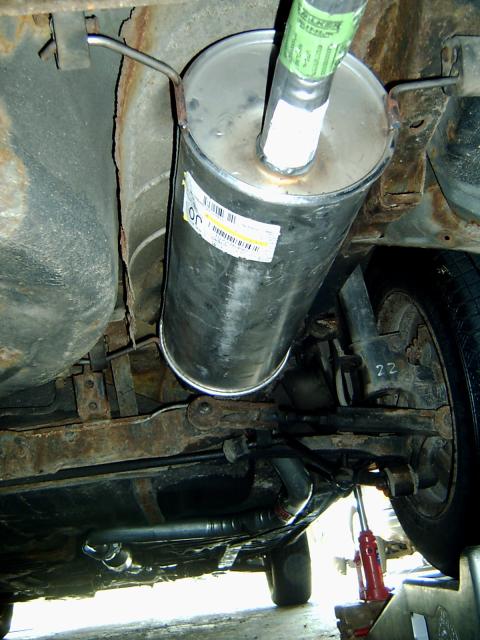
So, the new muffler works like a champ. The engine runs considerably smoother. The car is nearly silent. And it was only ten hours of work. Really, why would anyone do a job like this when they could get a pro to do it much faster, and with much less aggravation? In this case, the pro might have just welded new flanges onto the old muffler and straight pipe, bolted things back together, charged you less than the complete parts, and you'd be on your way in about an hour. It's possible that one interface or the other would have been unsalvageable, and they'd charge you for another part - maybe the muffler. With all new parts, this exhaust system should last at least three years, which is about one hundred thousand miles. It may never need replacing. If the old parts were welded back together, it would likely need replacing next year.
Well, for one thing the underside of the car was inspected in detail by the owner. This makes a difference. The pro has no interest, per se, in your car. They won't say you have a flat tire if it isn't their immediate job. This vehicle has 278,000 miles, and the question of how much life is left in the body is becoming important. If there isn't much left, perhaps putting significant repair into the car is a bad investment. Not that a car is an investment. It takes real time to do a good inspection. Rust on the outside may escape notice, but not when hand washing the exterior. Really. Do it the hard way once in a while. Unrelated systems will get the inspections they need.
One system that needed inspection was the brakes. There is a known brake fluid leak. Now it has been localized. While laying there trying to figure out what to do next, there was some fluid slowly dripping down the driver's side rear tire. Tough to trace back up, because there is so little of it. However, when the car came down off the ramps, there was little doubt that the pool of liquid on the plastic ramp was brake fluid. Diagnosis is expensive. That little tidbit is probably worth $100. More when one considers that it is tax-free.
 Is the glass half full or half empty? The optimist says
it is half full. The pessimist says it is half empty.
The engineer says that the glass is twice as large as
it needs to be.
Is the glass half full or half empty? The optimist says
it is half full. The pessimist says it is half empty.
The engineer says that the glass is twice as large as
it needs to be.
What parts of the pipes or muffler would you most like to see fail first? In the old days, the guts of the muffler would die, and it would just get a little louder. With small engines, you might not even notice. And pipes would rust out here and there. Some pipes had little holes for water to drain out. Did you know that one of the products of gasoline combustion is water? If the pipes get hot, the water stays vapor, and goes out the end. But for short trips, the pipes may not get hot enough, and water condenses on them. Then, when you are parked, the water contributes to the corrosion process, and you get rust through here and there.
My commute is long enough that everything is up to operating temperature. The car is hardly ever driven for less than an hour. It's not by choice, it's just the way it is. 37,000 miles a year. That's why it can't be junked. If a newer car is purchased, it is old before the payments are finished. Who can afford that? But, it won't be long now. Probably only another 100,000 miles. Less than three years.
The idea the the weld just up and died is abhorrent. And the idea that a pipe would rust through just past a joint seems fishy too. Ideally, the entire structure to fail simultaneously (or better yet, never). To have a failure in one spot tells me that part is under designed, and the rest is over designed. Certainly, the glass is too big.